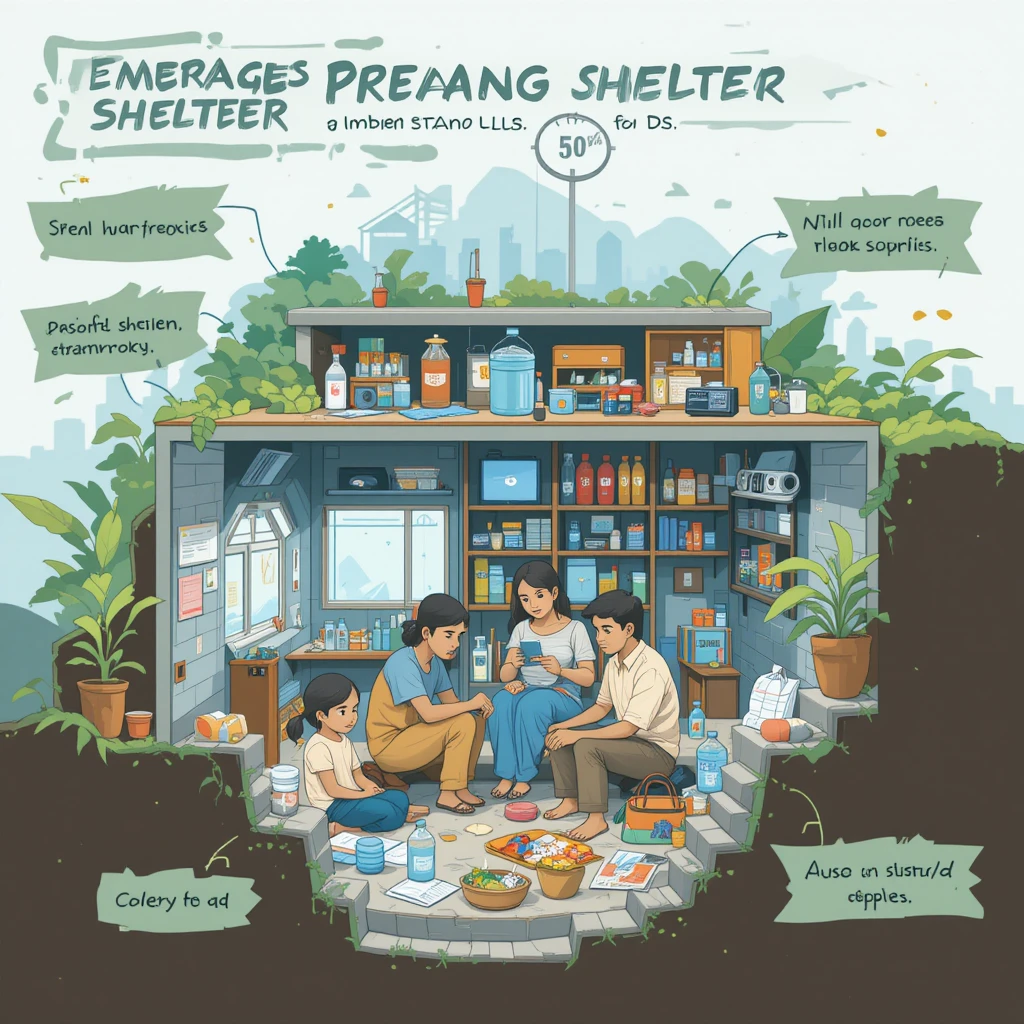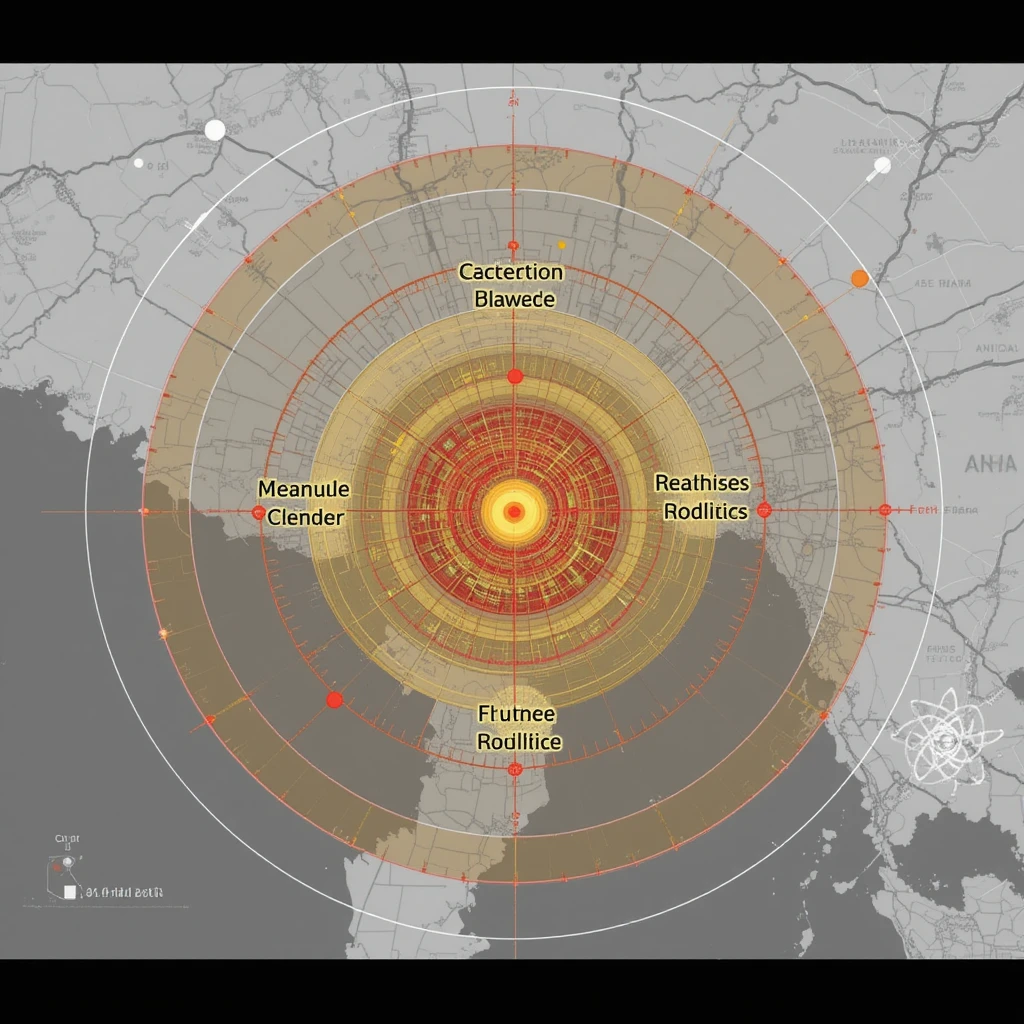Introduction
The specter of nuclear conflict looms large in South Asia, where India and Pakistan, both nuclear-armed states, share a volatile border marked by historical animosity and recurring military tensions. Pakistan’s military-driven nuclear strategy, characterized by ambiguity and a potential first-use policy, poses a significant challenge to India’s security. A nuclear detonation, whether strategic or tactical, would have catastrophic consequences, particularly in India’s densely populated urban centers and strategically vital regions. This article explores the precautions individuals and communities in India should take to prepare for a nuclear blast, the impact radius of such an event, survival strategies, and the country’s most vulnerable locations in the context of a hypothetical attack from Pakistan. Drawing on verified scientific studies, government guidelines, and strategic analyses, the article provides a roadmap for preparedness while critically examining Pakistan’s military strategies and India’s response options.

Table of Contents
Precautions for a Nuclear Blast
Preparedness is the cornerstone of surviving a nuclear detonation, which can occur with little to no warning. The following precautions are grounded in guidance from authoritative sources such as the U.S. Centers for Disease Control and Prevention (CDC), the Federal Emergency Management Agency (FEMA), and India’s National Disaster Management Authority (NDMA).
1. Identifying Safe Shelters
The most effective protection against a nuclear blast and its fallout is a well-chosen shelter. According to a 2010 FEMA report, shelters with dense materials (e.g., concrete, earth) significantly reduce exposure to blast effects and radiation (FEMA, 2010). In India:
- Underground Shelters: Basements, metro stations, or bunkers offer the best protection. For example, Delhi’s metro system, with its deep underground stations, could serve as a makeshift shelter.
- Building Interiors: If underground options are unavailable, the core of a sturdy building (e.g., interior rooms without windows) provides moderate protection. The NDMA recommends avoiding exterior walls and roofs, which are vulnerable to blast waves and fallout (NDMA, 2016).
- Community Planning: Local governments should map and publicize shelter locations, especially in high-risk areas like Delhi, Mumbai, and border cities.

2. Stockpiling Emergency Supplies
Survivors may need to remain sheltered for 1–2 weeks to avoid peak fallout radiation. The CDC advises preparing an emergency kit with:
- Food and Water: At least 14 days of non-perishable food and 1 gallon of water per person per day. Canned goods, dried fruits, and packaged meals are ideal (CDC, 2020).
- Medical Supplies: First-aid kits, prescription medications, and potassium iodide (KI) tablets to protect the thyroid from radioactive iodine. KI should be used only under medical guidance due to potential side effects (FDA, 2001).
- Communication and Tools: Battery-powered or hand-crank radios, flashlights, batteries, duct tape, and plastic sheeting to seal shelters.
In India, urban households should maintain these supplies, as infrastructure disruptions could delay relief efforts.
3. Staying Informed
Timely information can save lives. The NDMA emphasizes the importance of monitoring government alerts via radio, television, or mobile apps (NDMA, 2016). Families should:
- Establish communication plans with designated meeting points and contact methods.
- Subscribe to India’s Integrated Public Alert and Warning System (IPAWS) or state-level disaster apps for real-time updates.
- Avoid misinformation by relying on verified sources like All India Radio or the Press Information Bureau.
4. Learning Protective Actions
Immediate actions during a nuclear event can mitigate injury and exposure. The “Duck and Cover” technique, endorsed by FEMA, involves:
- Dropping to the ground to avoid the blast wave.
- Covering the head and neck to protect against debris.
- Shielding eyes from the thermal flash, which can cause flash blindness (FEMA, 2010).
Additionally, individuals should learn decontamination procedures: removing outer clothing (which can trap 90% of radioactive particles) and showering with soap to reduce contamination (CDC, 2020).
Impact Radius of a Nuclear Blast
The destructive effects of a nuclear explosion depend on the bomb’s yield, detonation type (ground or air burst), altitude, and environmental factors. Pakistan’s nuclear arsenal, estimated at 170 warheads in 2024, includes yields ranging from 1–10 kilotons (kt) for tactical nuclear weapons (TNWs) to 15–100 kt for strategic warheads, with some sources suggesting up to 350 kt (Kristensen & Korda, 2024). For this analysis, we model a 100-kt ground burst in a densely populated Indian city like Delhi, based on studies from the Lawrence Livermore National Laboratory (LLNL) and the NUKEMAP tool by Alex Wellerstein (Wellerstein, 2022).
1. Fireball and Thermal Radiation
- Radius: 0–0.5 miles (0–0.8 km).
- Effects: The fireball vaporizes everything within this radius, reaching temperatures of millions of degrees Celsius. Thermal radiation causes 3rd-degree burns up to 3–5 miles (5–8 km), igniting fires in flammable materials like wood and clothing (Glasstone & Dolan, 1977).
- Impact in Delhi: A 100-kt detonation in central Delhi (e.g., Connaught Place) would incinerate landmarks like India Gate and cause burns as far as Noida or Gurgaon, affecting millions.
2. Blast Wave
- Radius: Severe destruction within 0–2 miles (0–3.2 km); moderate damage up to 5–7 miles (8–11 km).
- Effects: The shockwave demolishes buildings, shatters windows, and causes blunt trauma. Near ground zero, fatalities approach 100%. At 5–7 miles, injuries from flying debris are common (LLNL, 2014).
- Impact in Delhi: Areas like Karol Bagh and Chandni Chowk would be obliterated, with damage extending to Rohini and Dwarka, collapsing infrastructure and trapping survivors.

3. Initial Radiation
- Radius: 0–1 mile (0–1.6 km).
- Effects: Lethal doses of gamma and neutron radiation cause acute radiation syndrome (ARS), leading to death within hours to weeks. Symptoms include nausea, vomiting, and organ failure (Waselenko et al., 2004).
- Impact in Delhi: Central Delhi residents would face immediate radiation risks, with dangerous levels potentially reaching Old Delhi.
4. Fallout
- Radius: 10–100+ miles (16–160+ km), depending on wind patterns.
- Effects: A ground burst generates radioactive particles that settle as fallout, carried by wind. Within 10–20 miles downwind, unsheltered individuals could receive lethal doses in hours. Radiation levels drop significantly after 48 hours but remain hazardous for weeks (Glasstone & Dolan, 1977).
- Impact in Delhi: Fallout could contaminate Uttar Pradesh or Haryana, depending on wind direction, affecting millions in cities like Ghaziabad or Faridabad.
For a 1-megaton bomb, effects would extend 2–3 times farther, with severe blast damage up to 5–10 miles and burns up to 10–15 miles. A 2019 study by Toon et al. estimates that a nuclear exchange between India and Pakistan, using 100–150 warheads, could kill 50–125 million people immediately and trigger global climate disruptions, causing 1–2 billion starvation deaths due to smoke-induced cooling (Toon et al., 2019).
Survival Strategies
Surviving a nuclear blast requires rapid decision-making and adherence to the principles of time, distance, and shielding (CDC, 2020).
During the Blast
- Duck and Cover:
- If the thermal flash is visible, drop to the ground, cover your head, and shield your eyes. Stay prone for 10–30 seconds to avoid the shockwave and debris (FEMA, 2010).
- Example: In a city like Mumbai, residents near Marine Drive should seek cover behind concrete structures or vehicles.
- Seek Immediate Shelter:
- Move to an underground or central building area within seconds to avoid blast effects and initial radiation. Metro stations (e.g., Churchgate) or mall basements are viable options.
- Avoid open areas or glass-heavy structures, which amplify injury risks.
After the Blast
- Shelter from Fallout:
- Remain in a sealed shelter for 24–48 hours minimum, ideally 1–2 weeks, to avoid peak fallout radiation. Basements or building cores offer the best protection (LLNL, 2014).
- Seal windows, doors, and vents with plastic sheeting and duct tape to block radioactive dust.
- Example: In Amritsar, residents could use gurdwara basements or school shelters, sealing entry points to minimize contamination.
- Decontamination:
- Remove outer clothing and seal it in a plastic bag to eliminate ~90% of radioactive particles. Shower with soap, avoiding open wounds, to reduce skin contamination (CDC, 2020).
- Do not consume food or water exposed to fallout. Use sealed supplies only.
- Monitor Radiation Levels:
- If available, use a Geiger counter to assess radiation risks. Without equipment, assume high risk near the blast site or downwind areas for 48 hours.
- Example: In Delhi, residents in unaffected areas like South Delhi should monitor radio updates for fallout patterns.
- Evacuation:
- Follow government instructions for evacuation, using designated routes to avoid contaminated zones. Bring emergency kits and avoid shortcuts through blast-affected areas.
- Example: In Punjab, evacuation routes could lead to Chandigarh or Himachal Pradesh, depending on fallout spread.
Long-Term Recovery
- Medical Care: Seek treatment for ARS symptoms (nausea, fatigue, fever) or burns. Radiation exposure increases long-term cancer risk, necessitating regular checkups (Waselenko et al., 2004).
- Resource Management: Expect disruptions in power, water, and healthcare for weeks or months. Coordinate with relief agencies like the NDMA or Red Cross for supplies.
- Psychological Support: Nuclear events cause trauma. Community support and mental health resources are critical for recovery (Norris et al., 2002).
Vulnerable Locations in India
India’s vulnerability to a nuclear attack stems from its dense population, strategic military assets, and economic hubs. In a hypothetical scenario involving Pakistan, targets would likely align with military and civilian priorities, as outlined in strategic analyses (Krepon & Cohn, 2010). Below are key vulnerable locations, based on their demographic, military, and symbolic significance.
1. Major Urban Centers (Countervalue Targets)
Pakistan’s strategy emphasizes targeting population centers to maximize civilian and economic damage, deterring India through high casualties (Toon et al., 2019).
- Delhi:
- Why Vulnerable: The political capital, housing parliament, ministries, and military headquarters (e.g., Army HQ). With over 30 million residents, a strike would disrupt governance and cause mass casualties.
- Impact: A 100-kt detonation could kill 1–2 million immediately, with fallout affecting Uttar Pradesh. The NUKEMAP tool estimates 500,000–1 million deaths from a 350-kt warhead (Wellerstein, 2022).
- Example: A missile like Pakistan’s Ghauri-II (range: 2,000 km) could reach Delhi in 15 minutes from Rawalpindi.
- Mumbai:
- Why Vulnerable: India’s financial hub, with 20 million residents, the Bombay Stock Exchange, and major ports. A strike would cripple India’s economy.
- Impact: A 100-kt blast in South Mumbai could destroy Colaba and Nariman Point, with burns reaching Thane. Fallout could contaminate Maharashtra’s coast.
- Kolkata, Bangalore, Chennai:
- Why Vulnerable: Regional economic and cultural hubs with dense populations (5–15 million each). Kolkata’s proximity to Bangladesh adds geopolitical risks.
- Impact: A 100-kt strike could kill 500,000–1 million per city, disrupting trade and IT sectors (Bangalore) or shipping (Chennai).
2. Military Installations (Counterforce Targets)
Pakistan’s doctrine prioritizes neutralizing India’s military capabilities, particularly airbases and command centers near the border (Krepon & Cohn, 2010).
- Pathankot, Udhampur, Srinagar:
- Why Vulnerable: Airbases in Punjab and Jammu & Kashmir, critical for operations along the Line of Control (LoC). Pathankot was attacked by militants in 2016, highlighting its exposure.
- Impact: A tactical nuclear strike (e.g., 5-kt Nasr missile) could destroy runways and aircraft, disrupting India’s air superiority.
- Adampur, Chandigarh, Awantipura:
- Why Vulnerable: Northern airbases within 100–300 km of Pakistan, targeted in conventional strikes in 2019 and 2025.
- Impact: A 10-kt TNW could render these bases inoperable, with fallout affecting nearby cities like Jalandhar.
- Western Bases (Bhuj, Nal, Phalodi):
- Why Vulnerable: Airfields in Gujarat and Rajasthan, within range of Pakistan’s short-range missiles (e.g., Hatf-II Abdali, 180 km).
- Impact: A strike could disrupt India’s Western Air Command, with fallout threatening border towns.
3. Nuclear and Industrial Sites
Attacking nuclear facilities could amplify radiological effects, though Pakistan’s precision capabilities may limit such strikes (Ramana, 2003).
- Bhabha Atomic Research Centre (BARC), Trombay:
- Why Vulnerable: India’s primary nuclear research facility near Mumbai, critical for weapons development.
- Impact: A strike could release radioactive materials, contaminating Mumbai’s suburbs.
- Tarapur Atomic Power Station:
- Why Vulnerable: A nuclear power plant in Maharashtra, 100 km from Mumbai.
- Impact: A 1981 U.S. study noted that reactor attacks could cause widespread radiological contamination, though modern reactor designs mitigate risks (Ramana, 2003).
- Kalpakkam (Chennai):
- Why Vulnerable: Hosts a fast breeder reactor and reprocessing plant.
- Impact: A strike could disrupt India’s nuclear fuel cycle, with fallout affecting Tamil Nadu.
4. Border Regions and Kashmir
The India-Pakistan border, particularly in Kashmir, is a flashpoint for escalation (Ganguly & Hagerty, 2005).
- Jammu, Srinagar, Akhnoor.
- Why Vulnerable: Militarized areas along the LoC, with frequent cross-border incidents. The 2019 Pulwama attack and subsequent Balakot airstrike escalated tensions, illustrating the region’s volatility.
- Impact: A tactical nuclear strike (e.g., 5-kt Nasr) on Akhnoor could halt Indian troop advances, with fallout affecting Jammu city.
- Punjab Border Cities (Amritsar, Ludhiana, Jalandhar):
- Why Vulnerable: Proximity to Pakistan (25–100 km) makes them targets for rapid missile or drone strikes. Amritsar’s cultural significance adds symbolic value.
- Impact: A 100-kt strike on Amritsar could kill 500,000, with fallout reaching Chandigarh.
- Rajasthan (Uttarlai, Phalodi):
- Why Vulnerable: Airbases within 100–400 km of Pakistan, targeted by missiles like the Shaheen-I (650 km).
- Impact: A strike could disrupt air operations, with fallout affecting Barmer or Jodhpur.
Pakistan’s Military-Driven Strategies
Pakistan’s nuclear and military strategies, overseen by its Strategic Plans Division (SPD) and National Command Authority (NCA), are designed to deter India’s conventional and nuclear superiority. Unlike India’s No First Use (NFU) policy, Pakistan maintains ambiguity, refusing to rule out first use (Krepon & Cohn, 2010). Below are key strategies, based on open-source analyses and declassified statements.
1. Nuclear Ambiguity and First-Use Posture
Pakistan’s doctrine leverages ambiguity to keep India uncertain about its nuclear thresholds. In 2001, Lt. Gen. Khalid Kidwai outlined four “red lines” triggering nuclear use:
- Significant territorial loss (e.g., Indian capture of Lahore).
- Destruction of military forces (e.g., airbases or corps).
- Economic strangulation (e.g., naval blockade of Karachi).
- Political destabilization (e.g., regime change efforts).
These vague thresholds allow Pakistan to escalate rapidly, even in response to conventional provocations (Chakma, 2012).
2. Tactical Nuclear Weapons (TNWs)
To counter India’s Cold Start Doctrine, which envisions rapid, limited strikes into Pakistan, Pakistan developed TNWs like the Nasr missile (1–10 kt, 60 km range). These weapons aim to stop Indian advances on the battlefield, such as in Punjab or Kashmir, but risk escalation to strategic strikes (Sankaran, 2015).
- Example Scenario: A 5-kt Nasr strike on Akhnoor could be followed by 100-kt strikes on Delhi and Mumbai to maximize damage, as modeled by Toon et al. (2019).
3. Strategic Targeting
Pakistan’s arsenal, including medium-range ballistic missiles (e.g., Shaheen-II, 2,000 km; Ghauri, 2,000 km), can target Indian cities and military bases. A 2019 simulation estimated that Pakistan could deploy 150 warheads (15–100 kt) on urban centers, causing 50–125 million deaths (Toon et al., 2019).
- Example: A simultaneous strike on Delhi, Mumbai, and Bangalore could disrupt India’s political, economic, and technological hubs.
4. Drone and Missile Warfare
Pakistan’s drone fleet (e.g., Chinese CH-4, indigenous Burraq) and missiles enable precise strikes. Drones could deliver conventional or nuclear payloads, targeting airbases or infrastructure to provoke India (Clary & Narang, 2019).
- Example: A drone attack on Pathankot could precede a missile strike, escalating tensions.
5. Proxy Attacks
Pakistan has historically supported militant groups (e.g., Lashkar-e-Taiba, Jaish-e-Muhammad) to conduct sub-conventional attacks, such as the 2008 Mumbai attacks or 2019 Pulwama bombing. These provoke India while avoiding direct nuclear escalation, but miscalculations could trigger retaliation (Ganguly & Hagerty, 2005).
- Example: A Pulwama-style attack could lead to Indian airstrikes, prompting Pakistan to signal nuclear readiness.
6. Strategic Signaling
Pakistan uses nuclear posturing (e.g., NCA meetings, missile tests) to deter India and invite international mediation. This strategy leverages global fears of nuclear war to limit escalation (Krepon & Cohn, 2010).
- Example: During the 2019 Balakot crisis, Pakistan’s release of a captured Indian pilot under U.S. pressure de-escalated tensions.
Critical Analysis
- Strengths: Ambiguity and TNWs deter India’s conventional superiority. Drones and missiles enable rapid, precise strikes. Signaling leverages international intervention.
- Weaknesses: Vague “red lines” risk miscalculation. Proxy attacks increase unintended escalation risks. Limited command-and-control safeguards raise concerns about unauthorized use (Clary & Narang, 2019).
- Risks: A nuclear strike, even tactical, could provoke India’s massive retaliation, targeting Pakistani cities like Karachi and Lahore, leading to mutual devastation. Global climate impacts could cause billions of deaths (Toon et al., 2019).
India’s Response Strategies
India must balance deterrence, preparedness, and diplomacy to counter Pakistan’s nuclear threat. The following strategies align with recommendations from the Stimson Center and India’s strategic community (Krepon & Cohn, 2010).
1. Strengthen Civil Defense
- Conduct regular nuclear attack drills in vulnerable cities like Delhi, Mumbai, and Amritsar. The NDMA’s 2016 guidelines emphasize public awareness campaigns (NDMA, 2016).
- Build public shelters in high-risk areas, such as Punjab and Kashmir, modeled on Israel’s civil defense infrastructure.
- Distribute KI tablets and educate communities on decontamination.
2. Enhance Early Warning Systems
- Deploy advanced radar and satellite systems to detect missiles and drones, as demonstrated in India’s 2019 air defense operations (Clary & Narang, 2019).
- Integrate with U.S. or Israeli missile defense systems (e.g., Arrow) to intercept Pakistani missiles, though effectiveness against nuclear warheads is limited.
3. Bolster Nuclear Deterrence
- Maintain a credible second-strike capability via submarines (e.g., INS Arihant) and mobile missile launchers (e.g., Agni-V, 5,000 km) to deter first use (Sankaran, 2015).
- Clarify NFU exceptions (e.g., chemical attacks) to counter Pakistan’s ambiguity while maintaining moral credibility.
4. Diplomatic Engagement
- Use hotlines and crisis communication protocols to avoid miscalculations, as recommended by the Stimson Center (Krepon & Cohn, 2010).
- Engage international mediators (e.g., U.S., UN) to de-escalate crises, leveraging India’s global economic clout.
- Pursue confidence-building measures (CBMs) like nuclear risk reduction centers, though Pakistan’s military dominance complicates progress.
5. Counter Proxy Threats
- Strengthen intelligence to prevent militant attacks, reducing triggers for escalation. The 2019 Pulwama attack underscored the need for proactive counterterrorism (Ganguly & Hagerty, 2005).
- Use surgical strikes or cyberattacks to deter Pakistan without crossing nuclear thresholds.
Conclusion
A nuclear attack on India, particularly from Pakistan, would be a humanitarian and strategic catastrophe, with millions of immediate casualties and long-term global consequences. By preparing shelters, stockpiling supplies, and learning protective actions, individuals can improve their survival chances. Vulnerable locations like Delhi, Mumbai, and border regions require prioritized civil defense measures. Pakistan’s military-driven strategies, while effective for deterrence, risk catastrophic miscalculation due to ambiguity and proxy reliance. India must counter these threats through robust deterrence, early warning systems, and diplomacy while fostering public resilience. International cooperation and risk reduction measures are critical to preventing nuclear escalation in South Asia. As the NDMA aptly states, “Preparedness is not just a choice; it is a necessity” (NDMA, 2016).
References
- Centers for Disease Control and Prevention (CDC). (2020). Radiation Emergencies: What You Should Do to Protect Yourself. https://www.cdc.gov/nceh/radiation/emergencies/
- Chakma, B. (2012). Pakistan’s Nuclear Weapons: Ambiguity and Deterrence. Routledge.
- Clary, C., & Narang, V. (2019). India’s Counterforce Temptations: Strategic Dilemmas and the Risk of Indo-Pakistani Nuclear Escalation. International Security, 43(3), 7–52.
- Federal Emergency Management Agency (FEMA). (2010). Planning Guidance for Response to a Nuclear Detonation. https://www.fema.gov/sites/default/files/2020-07/planning-guidance-nuclear-detonation.pdf
- Food and Drug Administration (FDA). (2001). Potassium Iodide as a Thyroid Blocking Agent in Radiation Emergencies. https://www.fda.gov/drugs/bioterrorism-and-drug-preparedness/potassium-iodide-ki
- Ganguly, S., & Hagerty, D. T. (2005). Fearful Symmetry: India-Pakistan Crises in the Shadow of Nuclear Weapons. University of Washington Press.
- Glasstone, S., & Dolan, P. J. (1977). The Effects of Nuclear Weapons. U.S. Department of Defense. https://www.dtra.mil/Portals/61/Documents/NTPR/4-Rad_Exp_Rpts/36_The_Effects_of_Nuclear_Weapons.pdf
- Krepon, M., & Cohn, J. (2010). Crises in South Asia: Trends and Consequences. Stimson Center. https://www.stimson.org/wp-content/uploads/2011/09/Crises-in-South-Asia-Trends-and-Consequences.pdf
- Kristensen, H. M., & Korda, M. (2024). Pakistani Nuclear Forces, 2024. Bulletin of the Atomic Scientists, 80(1), 34–42.
- Lawrence Livermore National Laboratory (LLNL). (2014). Nuclear Fallout: Protection and Decontamination. https://www.llnl.gov/sites/default/files/2021-06/nuclear_fallout.pdf
- National Disaster Management Authority (NDMA). (2016). Guidelines on Management of Nuclear and Radiological Emergencies. Government of India. https://ndma.gov.in/images/guidelines/nuclear_radiological_emergencies.pdf
- Norris, F. H., et al. (2002). 60,000 Disaster Victims Speak: Part I. An Empirical Review of the Empirical Literature, 1981–2001. Psychiatry, 65(3), 207–239.
- Ramana, M. V. (2003). Nuclear Power in India: A Critical History. Orient Blackswan.
- Sankaran, J. (2015). Pakistan’s Battlefield Nuclear Weapons and the Limits of the India-Pakistan Nuclear Confrontation. Strategic Analysis, 39(6), 645–659.
- Toon, O. B., et al. (2019). Rapidly Expanding Nuclear Arsenals in Pakistan and India Portend Regional and Global Catastrophe. Science Advances, 5(10), eaay5478.
- Waselenko, J. K., et al. (2004). Medical Management of the Acute Radiation Syndrome: Recommendations of the Strategic National Stockpile Radiation Working Group. Annals of Internal Medicine, 140(12), 1037–1051.
- Wellerstein, A. (2022). NUKEMAP: Nuclear Weapons Effects Simulator. Stevens Institute of Technology. https://nuclearsecrecy.com/nukemap/




